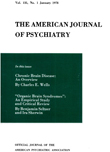Diagnostic instability and depression
Abstract
Blind raters applied research criteria to the charts of patients whose discharge diagnosis changed through several hospital admissions from depression to schizophrenia and to the charts of matched control patients. Fewer diagnostically unstable patients than control patients satisfied research criteria for depression despite matching discharge diagnoses. The use of operational criteria, then, can be expected to reduce diagnostic instability in depression and thus improve prognostic accuracy. Some patients satisfied the research criteria for depression when they were initially admitted and for schizophrenia at their final admission. This suggests that diagnostic error may not account for all cases of major diagnostic instability.
Access content
To read the fulltext, please use one of the options below to sign in or purchase access.- Personal login
- Institutional Login
- Sign in via OpenAthens
- Register for access
-
Please login/register if you wish to pair your device and check access availability.
Not a subscriber?
PsychiatryOnline subscription options offer access to the DSM-5 library, books, journals, CME, and patient resources. This all-in-one virtual library provides psychiatrists and mental health professionals with key resources for diagnosis, treatment, research, and professional development.
Need more help? PsychiatryOnline Customer Service may be reached by emailing [email protected] or by calling 800-368-5777 (in the U.S.) or 703-907-7322 (outside the U.S.).



